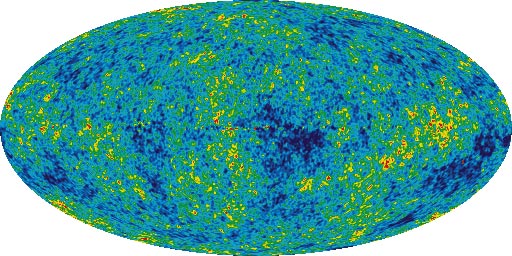Wonder - A Scientific Oratorio

Map of the Cosmic Microwave Background. The speckled patterns are the ripples that will eventually grow to become stars and galaxies.
Credit: NASA/WMAP.
Theme 3 - The fading glow of the Big Bang
Everywhere we point our telescopes we pick up the faint hiss of radio waves which have been travelling across the Universe for almost 14 billion years. This is the cosmic microwave background, the fading glow of the Big Bang. By studying it we can see far back in time almost to the Big Bang itself.
The temperature of the Universe when it became transparent was about 3,000 degrees. At this temperature the Universe would have glowed a dull red. This reddish light has been travelling through the Universe ever since.
However the Universe is now about one thousand times larger than when this light was produced. The light has been stretched by a thousand times, becoming redder and then invisible, moving into the infrared and eventually into the microwave part of the radio spectrum.
We can see this "radio light" arriving at the earth from all directions - we call it the Cosmic Microwave Background (CMB) radiation. The CMB is like a time machine, it gives us a glimpse into the Universe as it was almost 14 billion years ago. By studying the detailed differences in the pattern of this light in different directions we can even study the first structures to have formed at these early times - the building blocks of stars and galaxies.
Astronomy is a little like archaeology. In the latter the deeper you dig the farther back in time you look. In astronomy, because we see the Universe using light which travels at a finite speed, the father out in space we look the farther back in time we see. The CMB lets us look back in time almost to the beginning.



